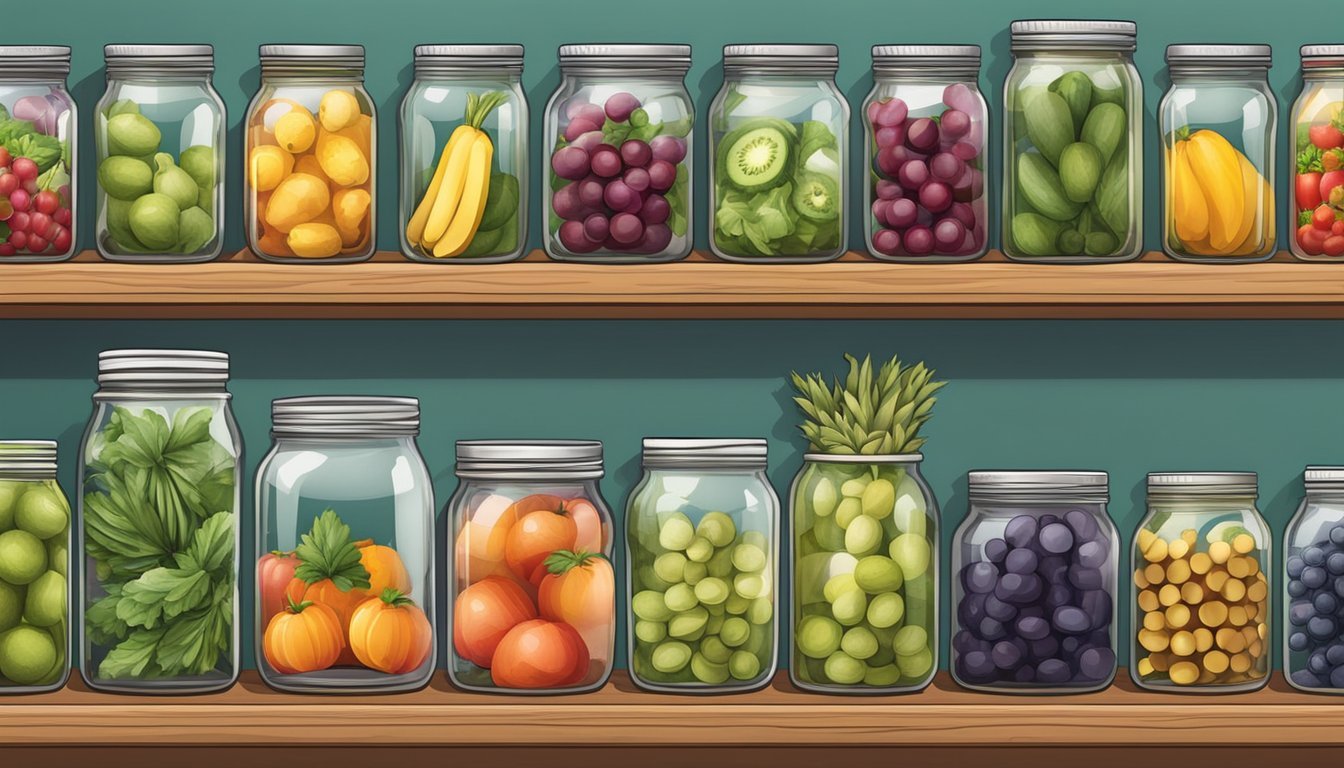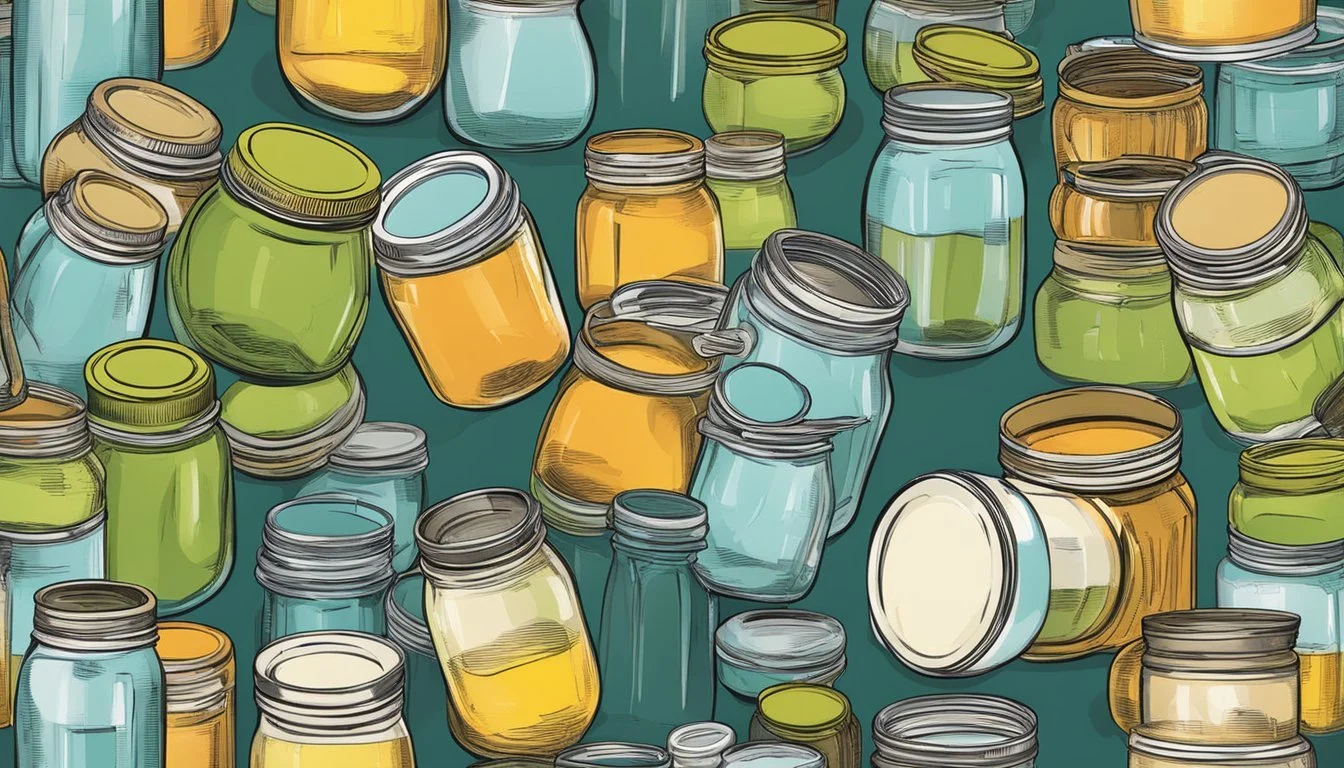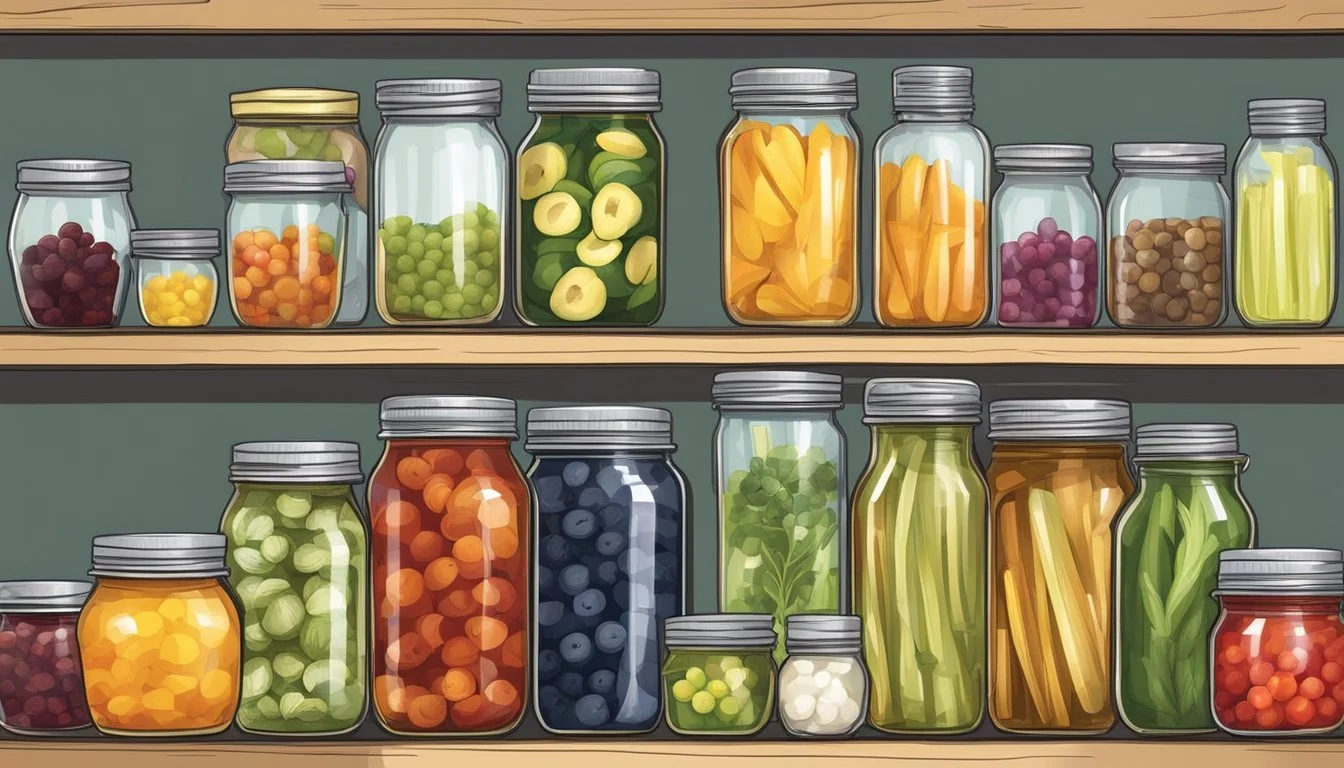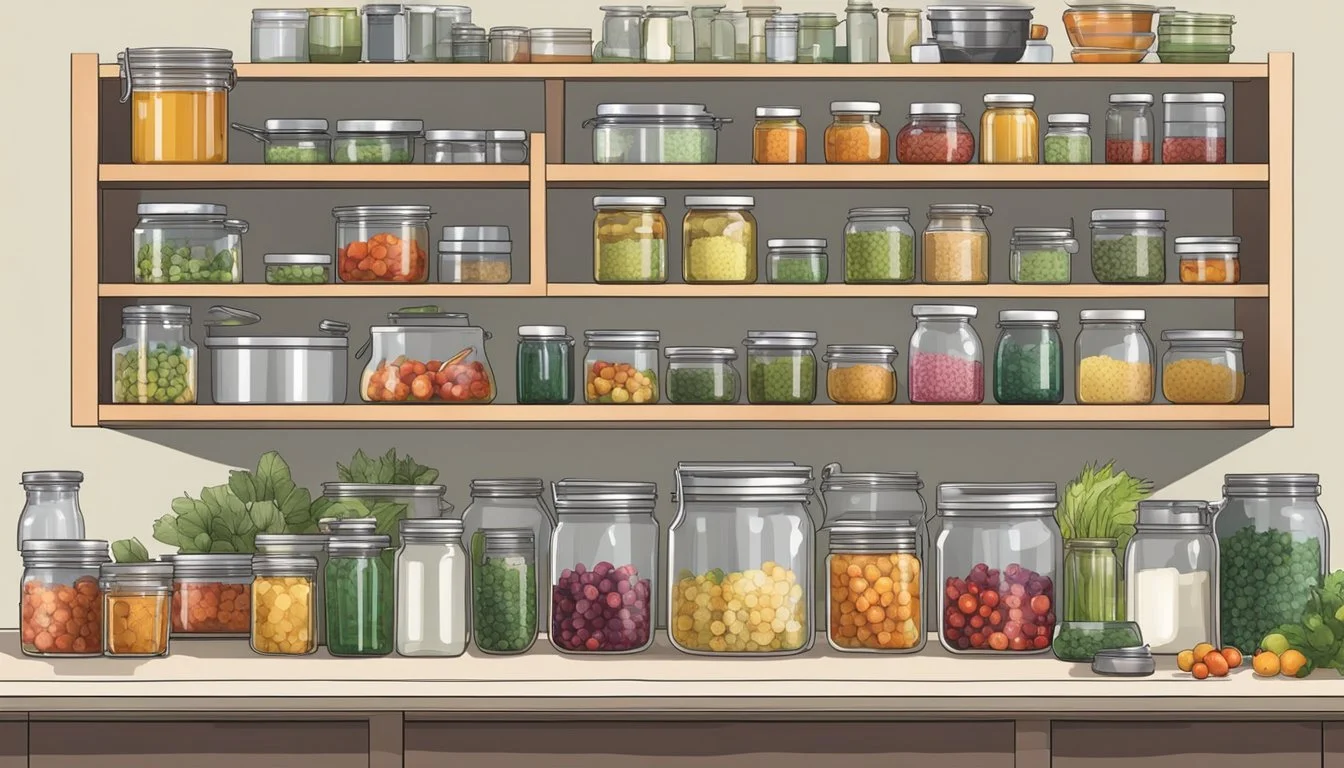Best Canning Jars for Home Canning
Durable Choices for Preserving Your Harvest
Canning is a method of food preservation that has stood the test of time, allowing individuals to store various foods for extended periods. Choosing the right canning jars is essential for ensuring the longevity and safety of preserved goods. The market offers a range of canning jars suitable for different types of foods, from jams and jellies to vegetables and sauces. The best canning jars provide a reliable seal, are durable, and come in sizes that meet the needs of home canners.
The popularity of Ball and Kerr mason jars has persisted due to their proven track record, availability in multiple sizes, and the two-piece lids that create an airtight seal, essential for the preservation process. These jars are also valued for their versatility, suitable for both high-acid and low-acid foods. In contrast, unique options like bail jars offer a distinctive two-part lid system that clamps the glass lid in place, providing both functional and aesthetic appeal. Whether for bulk preservation or small batches, the selection of the appropriate jar impacts the ease of use and success rate of canning endeavors.
History and Evolution of Canning Jars
The development of canning jars has been essential to food preservation at home. This section delves into the prominent mason jars and the technological advancements that have shaped modern canning methods.
Glass Canning Jars: Mason Jars and Their Legacy
The Mason jar, patented in 1858 by John L. Mason, is a cornerstone of canning at home. Mason's design included a threaded glass jar with a screw-on lid, which provided a reliable seal. This innovation spurred the popularity of canning food at home and glass canning jars are still as popular today.
Key Entities:
Glass Jars: Used for their clear material, allowing visual assessment of the canning process.
Ball Corporation: Began manufacturing glass jars in 1884, becoming a significant player in the market.
Kerr Jars: Introduced by Alexander H. Kerr, who patented the two-piece disposable metal lid in 1915, which is still a standard in canning today.
Canning technology has seen various improvements, including the transition from the original zinc lids to more practical and safer options.
Jars Evolutions:
Threaded Glass Jars: These featured metal lids with rubber gaskets for airtight sealing.
Two-piece Lids: Most commonly used in home preservation today, these consist of a flat metal lid with a rubber seal and a metal band.
Other Notable Brands:
Weck Jars: Known for their distinctive glass lids and rubber rings, adding variety to the canning jar market.
Types of Canning Jars
Choosing the right canning jar is essential for home preservation. Various sizes, materials, and brands are available, each serving a specific function based on the user's canning needs.
Canning jars typically come in standard sizes ranging from pints to quarts. The use of pint and quart jars depends on the volume of food to be preserved, with quart jars accommodating larger quantities. Each size is typically available with a small or wide mouth.
Canning jars are predominantly made of glass, a durable and heat-resistant material suitable for the canning process. The lids, often comprising a flat metal lid and a screw band, create an airtight seal essential for preserving food. Proper handling and storage are critical as glass can break, but generally, with careful use, jar breakage is rare.
Industry leaders in the canning jar market include:
Ball: Known for their smooth sides and available in both regular and wide-mouth options.
Kerr: Feature ridged sides with screw-on lids, similar to Ball jars, and are available in multiple sizes.
Weck: Recognized for its unique clip and rubber ring sealing mechanism making a great canning lid.
Each manufacturer has a reputation for quality and offers distinct features beneficial to different canning projects.
Selecting the Right Canning Jar for Your Needs
When preserving foods at home, the type of canning jar used is as important as the preservation method. The size and shape of the jar, as well as the type of seal it provides, are critical factors in ensuring the longevity and safety of your preserved goods.
Jars for canning come primarily in two mouth styles: regular mouth and wide mouth. Regular mouth jars typically have an opening of about 2 3/8 inches and are suitable for liquid-based foods such as jams and jellies. Wide-mouth jars have an opening of about 3 inches, making them more accessible for packing large items like whole fruits and vegetables.
Mouth Type Ideal for Regular Mouth Jams, Jellies, Pie Fillings, Salsas Wide Mouth Whole Fruits, Vegetables, Pickles
For seals, most canning jars use a two-part lid system that includes a flat lid with a rubber gasket and a separate band to secure it. This ensures an airtight seal which is crucial for creating the vacuum needed to preserve the food and keep it from spoiling.
Canning Procedures and Best Practices
Successful self-canning requires adhering to specified procedures and best practices to ensure food safety and product quality. Sterilization of canning supplies, proper filling of jars with attention to headspace management, and adherence to processing times and techniques are pivotal to creating a safe vacuum seal.
Sterilization Process: Canning jars and their metal lids must be sterilized before use to eliminate harmful microorganisms that can spoil food. The sterilization process often involves submerging jars and lids in boiling water for a certain period or using a dishwasher if it has a sterilizing function. It's crucial to ensure that the jars and lids are completely submerged in the water and are left in long enough to kill all bacteria.
Filling and Headspace Management: When filling canning jars, one must precisely manage headspace—the gap between the surface of the food and the rim of the jar. The recommended headspace for most canned products is typically 1/4 inch for jams and jellies, 1/2 inch for fruits and tomatoes, and 1 to 1 1/4 inches for low-acid foods to allow for food expansion and proper vacuum seal during the canning process. Using a non-metallic utensil to remove air bubbles and wiping the rim clean before sealing with a lid is essential.
Processing Times and Techniques: Processing times and techniques, such as water bath canning for acidic foods and pressure canning for low-acid foods, must follow tested and approved recipes to ensure food safety. The use of a water bath canner or a pressure canner depends on the type of food being preserved:
Acidic foods (pH below 4.6): Use water bath canning involving a canner filled with boiling water.
Low-acid foods: Require a pressure canner to achieve the higher temperatures necessary to prevent botulism.
Labels are also important, as they should include the contents and the date of canning to keep track of freshness and shelf life.
Canning Supplies; Equipment and Accessories
When preserving foods at home, having the right accessory equipment is essential for both safety and efficiency. The tools a canner chooses can greatly streamline the process and ensure the preservation is done properly
How many jars you need will need to be thought about and is dependent on both your needs and the storage space you have available. If you are looking to can an abundance then look into companies that sell bulk canning jars to save a little on your outlay.
A canner's toolkit should include several indispensable items for effectively and safely preserving food:
Canning Rack: Crucial for keeping jars off the bottom of the pot, allowing water to circulate freely for even heating.
Canning Funnel: Aids in transferring contents neatly into jars, minimizing spillage and waste. Look for:
Plastic Canning Funnel: Economical and easy to handle.
Jar Lifter: Essential for safely handling hot jars during processing.
Canning Lids and Rings: Necessary to create a vacuum seal that preserves the food within the jar. Options include:
Metal Lids: Traditional choice for creating a strong seal.
Canning Lids: Specifically designed for preserving, often come as two-piece lids (flat metal lid with a rubber seal and a separate metal ring/band).
Ladle: Used for portioning and transferring liquids or semi-liquids into the canning jars.
While not critical, the following optional canning supplies and tools can enhance the canning experience by adding convenience and perfection to the process:
Labels and Stick-on Labels: Helps identify and organize canned goods with crucial information such as contents and canning dates.
Magnetic Lid Lifter: Helps remove lids from hot water, ensuring sterile and burn-free handling.
Wrench: Some canners use a jar wrench to aid in opening jars or securing lids, though it's not generally recommended for fear of disturbing the seal of the lids.
Dealing with Common Canning Issues
When preserving foods at home, successfully sealing jars and maintaining the quality of the contents are fundamental for extending shelf life. Canners often encounter seal failures and preservation challenges, which can be addressed with proper techniques.
Seal failures often stem from improper application of screw-on lids or defects in the rubber gasket. Here are specific steps to tackle these issues:
Inspect Jar Rims: Ensure there are no nicks or cracks. Any imperfections can prevent an airtight seal.
Clean Rims Thoroughly: Remove all food residue before applying the lid to help secure the seal.
Preservation challenges can affect the shelf life and safety of canned goods. The following strategies can help maintain the integrity of home-canned items:
Use the Correct Headspace: Leave the right amount of space between the food and the lid to allow for proper expansion during processing.
Ensure Accurate Tightening: Lids should be applied firmly but not overly tight; a rubber gasket needs room to expand and create an airtight seal during processing.
Food Categories and Appropriate Jar Selection
Selecting the right canning jar is crucial for preserving quality and ensuring safety. Different food types require specific jar types to maximize shelf life and convenience during storage and use.
For jams and jellies, regular mouth jars are typically preferred. They make pouring the viscous mixtures easy and provide a good seal. The standard sizes are:
Half-pint jars (8 ounces) - ideal for small batches or gift-giving.
Pint jars (16 ounces) are versatile for regular home use.
Pickles and salsas require a jar that accommodates chunkier contents. Wide-mouth jars are excellent for these items because:
They make packing and removing large pieces easier.
The wide opening facilitates even distribution of brine and vinegar.
Common sizes for pickles and salsas are:
Pint jars (16 ounces) - suitable for family servings.
Quart jars (32 ounces) - best for larger batches.
Many people prefer glass canning jars for pickles especially if they are bulk canning jars, the glass allows you to see and identify the contents without reading the labeling.
For canning vegetables and meats, wide-mouth lids are again the top choice due to their:
Ease of filling with bulky items or larger pieces of meat.
Efficient removal of contents without disturbing the structure.
Sizes typically used for vegetables and meats include:
Pint jars (16 ounces) - good for small households.
Quart jars (32 ounces) - for families or preserving in bulk.
Canning Safety and Food Storage
When preserving food by canning, safety is paramount and determines the quality and shelf life of the final product. Proper canning methods and storage techniques are key to preventing spoilage and ensuring food safety.
Food Storage Risks: The canning process involves preserving food in airtight containers which are then heat-processed to kill any microorganisms. However, if done incorrectly, it can lead to foodborne illnesses.
Use USDA Guidelines: It is critical to follow the USDA's Complete Guide to Home Canning and Food Storage to mitigate these risks. This guide is a research-tested resource that ensures food safety.
Select the Right Jars: Jars must be made of tempered glass to withstand the heating process. Brands like Ball and Kerr offer reliable options. Granite Ware is a well-known brand for canning equipment, though it primarily offers pots and not jars.
Ensure a Good Seal: The integrity of the seal determines the safety of canned goods. A quality seal prevents microorganisms from entering and spoiling the food.
Canning Shelf Life: Properly canned and stored food can last for years, maintaining its taste and nutritional value.
Handle with Care: Before storing, ensure the jars have cooled down and the seal is secure by checking the lid's resistance to pressure.
Acidity Consideration: High-acid foods like fruits have a longer shelf life due to their natural preservative qualities, whereas low-acid foods require more careful heat processing.
Storage Conditions: Store jars in a cool, dark place and avoid extreme temperature changes to extend shelf life.
Inspect Regularly: Before use, inspect the jars for any signs of spoilage, such as an unsealed lid, discoloration, or off odors.
By adhering to these safety and storage guidelines, one can enjoy high-quality preserved foods throughout the year.
Pressure Canning vs. Water Bath Canning
The mastery of various canning methods ensures the safety and longevity of preserved foods. Two primary and advanced techniques, pressure canning and water bath canning, are used based on the acidity of the food being preserved, while steam canning serves as an alternative under specific conditions.
Pressure canning is essential for canning low-acid foods such as meats, poultry, and most vegetables. This method uses a pressure canner, a specialized pot that can achieve high temperatures exceeding the boiling point of water. It is vital in destroying botulism-causing bacteria that thrive in low-acid environments, which cannot be eliminated at the temperatures achieved by water bath canning.
On the other hand, water bath canning is suitable for high-acid foods including fruits, jams, and pickles. A water bath canner typically consists of a large pot, which is filled with water. Jars filled with high-acid food are submerged in this pot, and the water is then brought to a full boil for a specific period. This process creates a vacuum seal that preserves the food.
Key Equipment
Pressure canner: Designed to reach temperatures of 240-250°F (115-121°C).
Water bath canner: A large pot with a lid, capable of submerging jars completely in boiling water.
Recommended Use Cases
Pressure Canning: Vegetables (excluding tomatoes), meats, poultry, seafood, and dairy.
Water Bath Canning: Fruit, tomatoes with added acid, jams, jellies, pickles, and other high-acid foods.
Steam canning has gained attention as an alternative to traditional water bath canning. Instead of submerging jars in water, a canning pot designed for this method allows jars to be heated by steam alone. This can be more energy-efficient and requires less water, making it a lighter and often quicker option.
However, steam canning is not appropriate for all types of foods. Users must follow USDA guidelines, which typically recommend steam canning for high-acid foods. Similar to water bath canning, it relies on the heat of the steam to create the necessary vacuum seal for preservation.
Equipment: A steam canner with a rack, to hold jars above the required water level for steam generation.
Use Cases: Suitable for the same types of high-acid foods as water bath canning.
Understanding and correctly applying these advanced canning techniques can elevate the safety and quality of home-canned goods. Whether using a pressure canner for low-acid foods or choosing between water bath and steam canning for high-acid varieties, the process selected is critical for long-term storage and food safety.
Understanding Salts and Additives
When it comes to home canning, the types of salts and additives used can impact both the flavor and safety of preserved foods. Choosing the right kind of salt and understanding the role of various additives is crucial for ensuring the quality and longevity of canned goods.
Salt serves as a preservative and a flavor enhancer in canning. For vegetables like tomatoes, salt can improve texture and help maintain the product's natural color. Pickling salt is specifically recommended for canning because it is pure granulated sodium chloride without any additives that could affect the clarity or quality of the brine. Table salt, on the other hand, often contains anti-caking agents that could turn the brine cloudy or settle at the bottom of jars.
Recommended Salt for Canning:
Pickling salt
Not recommended:
Table salt with anti-caking additives
In addition to salt, a variety of additives may be used to achieve desired results in canning. They should be used as instructed by tested recipes to ensure safety and effectiveness. Additives may include:
Calcium chloride: A firming agent often used in pickling to maintain crispness.
Citric acid: (how long does citric acid last?) Added to acidify foods like tomatoes, helping ensure safety.
It is important to use canning additives in the intended way and to follow legitimate and research-tested canning procedures to avoid any risks associated with incorrectly preserved foods.
Expansion into Canning Alternatives
As home preservation trends evolve, enthusiasts are exploring beyond traditional canning. Options such as freezing offer an alternative while operating alongside established methods like water baths and pressure canning.
Freezing as a Preservation Method
Freezing is a reliable preservation method that maintains the taste and nutritional value of foods. Garden produce, in particular, can be preserved effectively through freezing. The process is straightforward: one must simply clean, optionally blanch, and pack the produce in freezer-safe containers before placing it in the freezer.
Key steps to freeze garden produce include:
Select: Choose fresh, ripe produce from the garden.
Prepare: Wash thoroughly and cut into desired sizes.
Blanch: Briefly cook in boiling water, then plunge into ice water to stop the cooking process (for most vegetables).
Package: Dry the produce and pack it into airtight, freezer-safe containers.
Freeze: Label with the date and content before freezing.
Comparison with Canning
Freezing remains distinct from canning. They differ primarily in equipment, shelf stability, and taste.
Aspect Canning Freezing Equipment Needed Canning jars, canner, jar lifter Freezer-safe containers, freezer Shelf Stability Years if sealed Months to a year Taste after Preservation Close to fresh, slight change Very close to fresh Suitable for Acidic & preserved foods Nearly all foods Considerations Requires more time and effort Requires continuous electricity
For those with glass-top stoves, it's vital to note that not all canning equipment is suitable for use on these surfaces. Conversely, freezing does not present such limitations and can be an accessible alternative for those with such stovetops.
Eco-Friendly and Sustainable Practices
The craft embraces both eco-friendliness and cutting-edge technology. These advances aim to enhance the sustainability of canning practices as well as improve the ease of use and reliability of canning equipment.
Mason-type Glass canning jars, traditionally known for their durability and versatility, are now seeing a shift towards greener practices. Manufacturers like Ball Mason Jars and Verones are exploring the use of recycled glass and sustainable materials to lessen the environmental impact. The transition to plastic lids—often BPA-free and reusable—instead of single-use metal lids, is also part of the movement towards sustainable canning.
The use of screw-on lids made from recycled materials is gaining traction.
Wide-mouth canning jars facilitate easier filling and cleaning, reducing water and resource usage.
Companies like Bormioli Rocco have introduced fancy jars, like the Quattro 8.5-Ounce Canning Jar, which are not just for aesthetics but also made with eco-conscious methods.
Advancements in technology are revolutionizing the at-home food preservation process. Companies are designing smart canning systems that integrate with home appliances for more precise temperature and timing control, enhancing food safety and simplifying the canning process.
Innovators like All American are rumored to be developing advanced canners with built-in sensors to ensure perfect preservation conditions.
High-tech vacuum sealers are equipped to work alongside jars like Ball Mason Jars to deliver an airtight seal that's crucial for long-term storage.
Bormioli Rocco and other jar producers are considering integration with home inventory systems, allowing users to track and manage their preserves efficiently.







